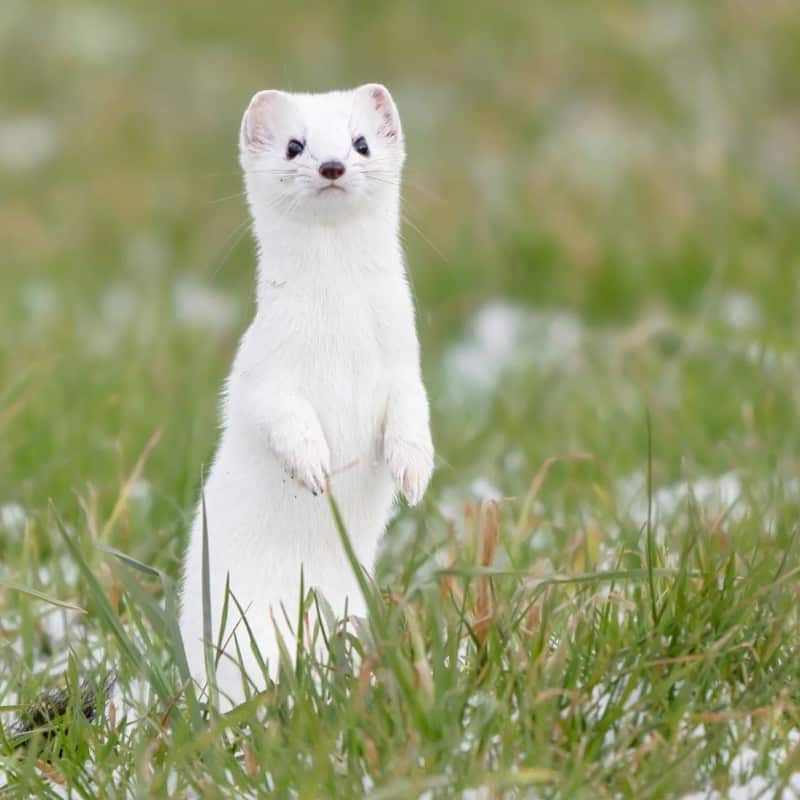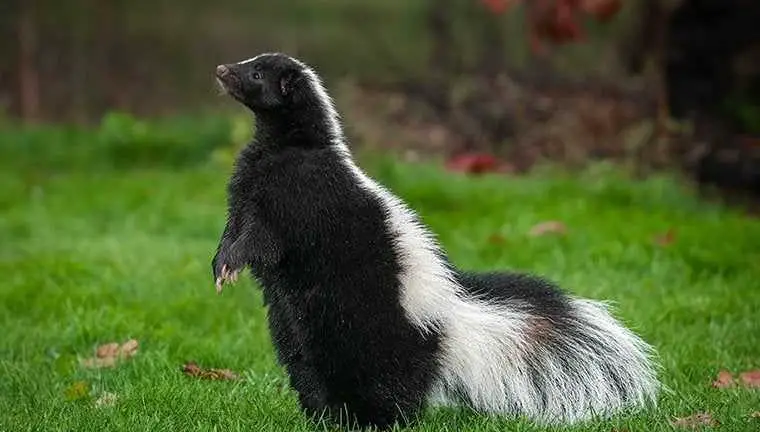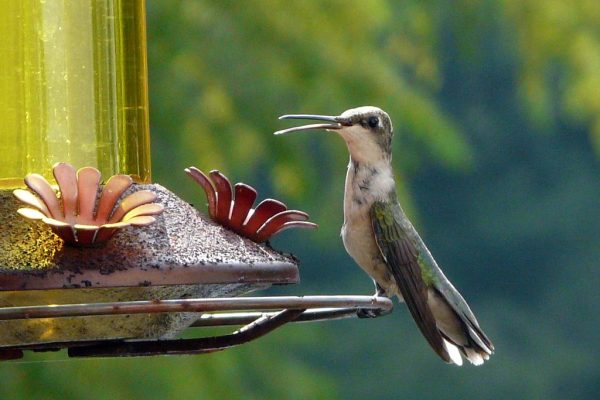The ability of skunks, which are omnivorous mammals, to repel predators with a toxic liquid spray is their most well-known feature. Thiols, which are also found in onions and garlic, are among the chemicals that make up this foul-smelling secretion. The skunk’s primary means of protection from predators is its extraordinary ability to direct its anal glands toward the eyes of an assailant, resulting in acute irritation and temporary blindness.
Although the skunk’s stench serves as a powerful defense, a number of other animals can easily hunt down these foul-smelling animals. Skunks are frequently preyed upon by bobcats, coyotes, foxes, and great horned owls. Skunks may also be killed and eaten by raccoons, weasels, and opossums.
It’s interesting to note that house cats are among the few animals that will not consume a skunk. According to a 1990 research, domestic cats avoid skunks because they find the scent offensive.
This article will examine the position of skunks in the food chain. Everything you ought to know about these repulsive critters will be covered.
What Makes Skunks So Odorous?
Skunks release an offensive-smelling secretion to keep predators away, which is why they smell. This toxic liquid is secreted by a gland located in their anus. They will spray the foul-smelling fluids at the predator and tilt their rear end towards it if they feel threatened.
Many substances, including thiols, which are also found in onions and garlic, make up this secretion. It smells like rotten eggs, which is hard to get rid of. In addition to having a terrible smell, this oily secretion irritates the skin and eyes.
It releases an odor so potent that it can be detected up to a mile away.
Editor’s note: If a skunk gets you in the eyes, don’t freak out—it happens. Though it will pass, you’ll feel as though you’re going blind. The secretion doesn’t harm anyone permanently.
It’s also important to remember that skunks don’t always release this secretion. Although the majority of people believe that skunks are always smelly, this belief is only triggered by fear. They behave exactly like any other animal the rest of the time.
The skunk’s special ability to point its anal glands at an attacker’s eyes serves as its primary line of defense against predators. Once a skunk has activated its defensive mechanism, it is extremely difficult to capture.
Which Animals Are Skunks’ Main Predators?
You’d think skunks have it easy in nature because of how strong their defense mechanism is. That’s hardly the case, though, as a number of animals happily hunt these foul-smelling creatures.
Skunks are regarded as a delicacy by many other animals and are an essential component of the food chain.
The Great Horned Owl

The great horned owl is one of the skunks’ most frequent predators. Because they hunt at night, these owls can more easily catch their prey off guard. Sharp beaks and talons are used by great horned owls to kill their prey.
Skunks’ liquid is nearly useless since they find it extremely difficult to recognize that great horned owls are attacking them. A skunk effectively defending itself against a great horned owl is extremely uncommon.
Bobcats:

Skunks are frequently preyed upon by bobcats. With their sharp claws, these predators—which are bigger than house cats—kill their prey. Being skilled hunters, bobcats can easily take down a skunk.
Bobcats use stalking to bring down skunks. They’ll wait for the skunk to approach by hiding in the bushes. When the skunk gets close enough, the bobcat will leap on it and use its razor-sharp claws to kill it.
The key is to avoid giving the skunk any time to respond.
Mountain Lions

Skunks can also be eaten by mountain lions. These big cats are found in western Canada and the United States. Being skilled hunters, mountain lions can easily take down a skunk.
Their hunting strategy is akin to the bobcat’s. When their prey is within reach, they will stalk it and then jump on it. Of course, whether or not they can sneak up on the skunk without being noticed will determine the outcome of their hunt.
If they don’t succeed, they’ll have to deal with the skunk’s vengeful liquid. Not only will they smell like they’ve died and run away with a bad itch, but their pride will be permanently damaged.
Coyotes

Another frequent predator of skunks is coyotes. These creatures, which belong to the dog family, are well-known for their scavenging ways. Skunks are just one of the many things that coyotes will eat.
Coyotes have a big advantage over skunks because they hunt in packs. They will encircle the skunk and bide their time until it releases its repulsive fluid. Upon the skunk expelling its fluid, the coyotes will advance to secure the kill.
Foxes

Foxes are animals that resemble dogs. They have a bushy tail and piercing ears. They eat almost anything and are found all over the world. Stalking is their preferred method of hunting.
Their pounces are so fast that their prey have very little time to react, making them dangerous. Like the majority of other skunk predators, foxes hunt during the hours when the skunk is preoccupied and unaware of their presence.
Given that foxes are also scavengers, it is more likely that they will search for dead skunks than pursue living ones.
Badgers

Another frequent predator of skunks is badgers.
One fascinating thing to note about badger hunting is that they frequently hunt alongside coyotes. Even though it seems counterintuitive—they can’t both eat the same food—this is a useful hunting tactic. The badger will wait in ambush while the coyotes pursue the skunk. When the skunk runs out of energy, the badger will close in to make the kill.
They do this because it increases the likelihood of long-term survival for both species.
When hunting by themselves, they’ll hide and attack the prey as soon as it comes into range, preventing it from having an opportunity to defend itself.
Weasels

Weasels are small, whitish and brown animals that inhabit the wild. As predators, weasels consume other small animals. They kill their prey with their razor-sharp teeth and claws. Another well-known trait of weasels is their capacity to pilfer eggs from bird nests.
Weasels usually target baby skunks when it comes to skunks. The young skunks will be killed and eaten by them. Despite their small size, weasels pose a serious risk to skunks.
Note from the editor: Although skunks have a number of predators, they are still a fairly common animal. This is because they can spray their toxic liquid at would-be predators, and they reproduce quickly. Hence, even though they might not be the most well-liked animal, skunks are undoubtedly here to stay.
Additional Defense Mechanisms of Skunks
Skunks have a second, less well-known defense mechanism in addition to their well-known one.
Being nocturnal animals, skunks are most active at night. Usually, this is when they go food hunting. Skunks, on the other hand, also sleep during the day. They are particularly susceptible to predators while they are sleeping.
Skunks frequently sleep in dens to protect themselves from predators. Skunks use their claws to dig small, underground tunnels that they call dens.
Skunks have a secure place to sleep during the day in their dens. They also offer defense against the bitter cold during the winter.
Skunks frequently hide in their dens when they feel threatened. Additionally, skunks will give birth to their young in their dens.
However, the combination of their strong glands and unique fur color is their greatest asset.
The Fur of Skunks
Skunks can be recognized by their distinctive black fur with white stripes. This seems contradictory—wouldn’t small animals prefer to blend in with their surroundings given the abundance of predators? However, in the moonlight at night, their white stripes are incredibly noticeable.
This is because skunks prefer to be noticed. If they have the misfortune of being sprayed by a skunk, the majority of predators will never want to approach one again. The smell is strong and can last for several months.
Therefore, if you don’t want to get sprayed, heed the warning indicated by the skunks’ white stripes. Predators are effectively discouraged by this method because most animals avoid unpleasant-smelling objects.
Final Thoughts
In the wild, skunks have many predators, but they typically manage to procreate more quickly than their attackers can eliminate them. Although their repulsive spray is their most well-known defensive technique, skunks also use their fur color and den-dwelling habits to keep predators away from them. Skunks will always be around.
In comparison, humans kill a great deal of skunks—mostly unintentionally. Skunks are most threatened by cars, then by people who try to kill them due to their stench. Please use caution if you come across a skunk on the road! Additionally, there are far more humane methods than killing one to get rid of one. All skunks are trying to do is get by in a hostile environment.
Since skunks are typically considered nongame, recreational hunting is not permitted.
It’s best to ignore wild skunks when you come across them.





